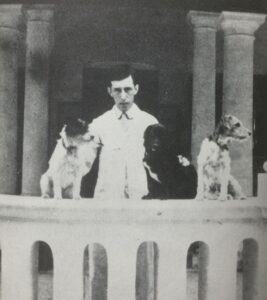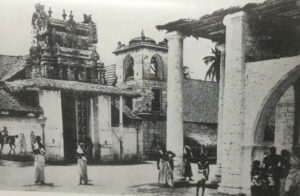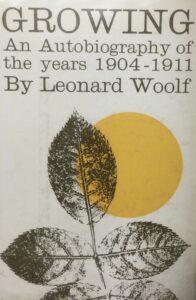by Sachi Sri Kantha, November 17, 2025
Introduction

Leonard Woolf in Jaffna circa 1905
Leonard Woolf (1880-1969) was the husband of influential British novelist Virginia Woolf nee Stepehen (1882-1941), who committed suicide. November 25th marks his 145th birth anniversary. He is one of the few writers of the 20th century, whose contributions were eclipsed by their wives. Still, five volumes of autobiographies, written by Woolf after he reached 80, remains fascinating books. These five volumes were, in chronological order,
Sowing:Years 1880-1904. – published in 1960
Growing: Years 1904-1911 – published in 1961
Beginning Again: Years 19111-1918 – published in 1964
Downhill All the Way: Years 1919-1939 – published in 1967
The Journey not the Arrival Matters: Years 1939-1969 – published in 1969.
Among these five volumes, the second volume Growing, covers the period Woolf spent in colonial Ceylon, after he was posted as a Cadet to the Ceylon Civil Service following his graduation from Trinity College, Cambridge. I provide two photos nearby, provided in this volume. One is that of young Leonard Woolf himself, taken in Jaffna. The second photo is that of an unidentified Hindu temple. What is noticeable is the attire of individuals photographed. All except the one in the right extreme are men with upper half exposed. The middle-aged woman in the extreme right wears a sari. Faces of individuals are blurred. From the shadow of two men standing in the middle, it can be inferred that the photo was taken in a bright mid-day.

An unidentified Hindu temple in Jaffna, circa 1905-1907 from Leonard Woolf’s book ‘Growing’
Volume 1 – Sowing (published in 1960) providing a prelude to Jaffna Experience
Volume 1 completed in 224 pages has only two chapters. Chapter 1 entitled ‘childhood’. Chapter 2 entitled ‘Cambridge’. In page 89 of chapter 1, Woolf provided this bit of his sexual awakening.
“The facts about copulation and the birth of children were explained to me, as I have said, by a small boy at my private school [i.e, Arlington House, Brighton] in the worst possible way and to some extent inaccurately – I was left in some doubt as to the sexual functions of the female navel – when I was twelve years old. I remained a virgin until the age of twenty five: the manner in which I lost my virginity in Jaffna, the Tamil town in the north of Ceylon, I will relate in a later chapter. In the thirteen years of chastity and youth which intervened, my mind and body were continually harried and harassed, persecuted and plagued, sometimes one might even say tormented and tortured, by the nagging of sexual curiosity and desire.”
The last sentence above covers the period from 1892 to 1905. Then, readers become curious to find some details about the lady (ladies) Woolf had courted during his stay in Jaffna, to satisfy his ‘sexual curiosity and desire’.
Volume 2: Growing (published in 1961)
 Volume 2 has 256 pages, and consist of 5 chapters. These are, chapter 1 – The Voyage Out, chapter 2 – Jaffna, chapter 3 – Kandy, chapter 4 – Hambantota and chapter 5 – Epilogue.
Volume 2 has 256 pages, and consist of 5 chapters. These are, chapter 1 – The Voyage Out, chapter 2 – Jaffna, chapter 3 – Kandy, chapter 4 – Hambantota and chapter 5 – Epilogue.
Chapter 2 describes the life spent by Woolf in Jaffna, in 112 pages. This is a charming record of Jaffna scene for two and a half years (from Jan 5, 1905 to Aug 18, 2007). But, in the Foreword, Woolf had cautioned the readers cryptically that he couldn’t record the truth for primary reasons. First, time distortions due to old age. He was writing about the events that happened more than 50 years ago, in 1961. Secondly, he had to ‘occasionally invent fictitious names for real people’.
I like the style, by which Woolf had presented his case. So, I reproduce his own words:
“I have tried in the following pages to tell the truth, the whole truth, and nothing but the truth, but of course I have not succeeded. I do not think that I have anywhere deliberately manipulated or distorted the truth into untruth, but I am sure that one sometimes does this unconsciously. In autobiography – or at any rate in my autobiography – distortion of truth come frequently from the difficulty of remembering accurately the sequence of events, the temporal perspective. I have several times been surprised and dismayed to find that a letter or diary proves that what I remember as happening in, say, 1908 really happened in1910; and the significance of the event may be quite different if it happened in the one year and not in the other. I have occasionally invented fictitious names for the real people about whom I write; I have only done so where they are alive or may be alive or where I think that their exact identification might cause pain or annoyance to their friends or relations.”
Nevertheless, Woolf’s description of his encounters in Jaffna make interesting reading. Did he provide any details about the lady with whom, Woolf experimented his sexual curiosity? Was she a native, or a non-native? Woolf description in the Jaffna chapter is about one ‘Gwen’, with whom he took a ‘walk’ and spent time with her on a sea beach. One may guess that this is a fictitious name to hide the identity of the woman. ‘Gwen’ is mentioned in four locations. The references are as follows:
“Not very far from us at that time lived two young English girls with their widowed mother. They used to take a walk on the beach in the (comparative) cool of the evening, and Templer and I got into the habit of joining them. One of them, Gwen, was pretty, lively, sweet-natured and I became fond of her and she of me. In 1906 it was highly improper in Ceylon that these two young women should wander about on the beach with two young men after dark and I often pondered over why their mother, a most respectable lady, allowed it. After the fierce heat of the day a gentle, languid, and pleasant melancholy would settle over the lagoon and over us as we lay on the seaweedy sand platonically – if that is the right word – in each other’s arms. For many years, long after she married and had a family, she used occasionally to write to me, and even up to today whenever I suddenly get the strong smell of seaweed, as in the town of Worthing, I get a vivid vision of Gwen and the sands of Jaffna.” (pp. 102-103)
In the next chapter, captioned ‘Kandy’, Woolf include one sentence as follows: “My two and a half years in Jaffna, the Prices, Gwen and the seaweedy sands on the shore, my bungalow on the wall of the Fort – all this seemed already to have faded away into a long-forgotten dream.” (p. 133), While at Kandy, Woolf experienced another romantic entanglement with a young girl, Rachel Robinson (aged 19, in 1907). This appears to be a real name, because he provides more details about her elder sister Ethel Robinson (aged 22, in 1907) and her mother Mrs. Robinson! – wife of a planter.
In the following chapter, captioned ‘Hambantota’ Woolf had included a sentence within parenthesis mentioning both Gwen and Rachel, as follows: “Nobody thought or talked of the things which I was passionately interested in. What I thought and felt about this I had to conceal from everyone in Jaffna and Kandy (except perhaps from Gwen on the seashore and Rachel in the mountain)” (p. 172)
In the final short chapter, ‘Epilogue’, Woolf closes his Ceylon stay with the following sentences: “Our boat left Colmbo on May 24, 1911, and arrived at Marseilles on June 10th. We took the train across France and next day, Sunday June 11th, got back to London…What I found in England and my life in London after June 1911, belongs to the third volume of my autobiography, if I ever write it. Here I am merely concerned with the ending of my life in Ceylon.” Once again, he had mentioned the names of places and folks he interacted with in Ceylon – “After Jaffna, Kandy and Hambantota, the Prices and Lewises, Gwen and Rachel it was a plunge – a slightly icy plunge – into an entirely different world, almost a different universe.”
But, in the Jaffna chapter, Woolf also provides another brief description of his encounter (a one-night stand) with a native Burgher woman. Other than Gwen, one is tempted to guess that Woolf could have lost his virginity to this ‘young girl’. His description was as follows:
“Being on a horse I could see over the blinds on to the verandahs. As I passed one of the houses, I happened to look into the verandah and a Burgher girl sitting there smiled at me and I smiled at her. A little further on I was crossing an open space which led down to the seashore and my bungalow. Suddenly I heard a thin voice saying: ‘Sah! Sah!!. I looked down and there was minute boy, about seven years old, trotting along by the side of my horse. I asked him what he wanted, and he said: ‘Sah! Sah! That young girl ask whether she come to your bungalow tonight.’ I very foolishly said yes, and she came and spent the night with me. The ‘young girl’, I discovered, though the niece of one of my own very respectable clerks, was a notorious Jaffna character – a ‘loose liver’, as they said; at the moment she was being kept by a Tamil lawyer”
Woolf’s Views on Hinduism
Wolf visited Ceylon again in 1960, after a lapse of 49 years, when he was 80. And he had mentioned about meeting Sir Kanthiah Vaithianathan (1896-1965), a Civil Service officer and an ex-Cabinet Minister for a short period in the UNP government. To quote,
“Hinduism, which was all about me for my two and a half years in Jaffna, is entirely different. In its ordinary, everyday form it repels me – the multiciplicity of its florid Gods, their grotesque images, the ugly exuberance of the temples, the horrible juggernaut processions with the terrible retinue of fakirs, saniyasis, and beggars. All this prejudiced me against Hinduism and made me, I think, blind to some of its manifestations during my years in Ceylon. When I visited the island again after fifty years in 1960, on my way to Mannar I met in the Anudadhapura Rest House Sir Kanthiah Vaithianathan. When he heard that I was going on to Mannar, he asked me to come and see him at his house there and also the Hindu Tiruketheesvaram temple which he is restoring at great cost. He explained to me, as we went round, the symbolism behind the images and the ceremonies, and in his very clear and sincere exposition I got for the first time some idea of what ‘higher’ Hinduism meant to a civilized man like my host.”
Named Tamil Individuals and non-Natives residing in Jaffna
In the chapter on Jaffna, Woolf identified four Tamil individuals, but only three by name. These are,
☆ Harry Sanderasekara, a variant spelling of Henry Alexander Patrick Sandrasagra (1875-1940), a renowned lawyer and legislator.
☆ V. Casipillai, identified by Woolf as a leading lawyer and respected man in Jaffna.
☆ a ‘great Sinnatamby’, identified by Woolf as a keeper of Jaffna’s tennis court, ‘might have been a character in a Kipling story’, a big stoutish Tamil in a voluminous white cloth and towering turban, who served drinks.
☆an unnamed Tamil lawyer, who had a young Burgher girl as a paramour
Non-native English individuals identified by Woolf in the Jaffna chapter are,
Retired Government agent, Sir William Twynam, aged 79.
Government agent at Jaffna, P.A. Dyke
Government agent, John Penry Lewis, aged 50, transferred to Kandy
Government agent Ferdinando Hamlyn Price, aged 51.
Assistant Government agent for Mannar, John Scott, aged 28
Assitant Government agent for Mullaitivu, R.A.G.Festing, aged 30
Assistant superintendent of Police, James Stewart Bowes
Assistant Conservator of Forests, G.D. Templer
District judge and police magistrate, Sanders, aged 49.
Provincial engineer, Waddell
Police magistrate, B.J. Dutton
Office Assistant to Government agent, Wilfrid Thomas Southorn (Tom Southorn)
Lady missionary, Miss Case, aged about 26 or 27.
Lady missionary, Miss Beeching, aged about 26 or 27; subsequently married Police magistrate B.J. Dutton.
Widowed mother and two young English girls, one was Gwen.
Views on Autography writing
Woolf’s expressed thoughts on autobiography writing (expressed in 1961), are realistic and informative, and I do agree. It’s this:
“In writing an autobiography I find that every now and again I am in considerable doubt whether I ought or not to include some trivial or highly personal incident. Having been for 40 years both an editor who has to publish reviews by other people and a reviewer myself, I am very rarely surprised by what reviewers say. But I was slightly surprised (and much amused) to find that some reviewers of Sowing, the first volume of my autobiography, were irritated – almost outraged – by the fact that, though an intelligent man, I wrote quite simply about some incidents and my own reactions to them. For instance, the reviewer in the Times Literary Supplement said that he was ‘startled’ because I remarked that ‘I remained a virgin until the age of twenty five; the manner in which I lost my virginity in Jaffna the Tamil town in the north of Ceylon, I will related in a later chapter.’ The reviewer goes on to say: ‘Surely most people would find it natural to say either more or less about this event’, and he complains that ‘again and again throughout the book the reader is given like occasions to wonder how such an intelligent man can claim to have such simple reactions.’ What amuses me in this is the writer’s profound ignorance, not merely of my psychology, but of the way in which the mind and heart of all men, intelligent or unintelligent, work. Of course, many of the reactions of intelligent people are just as ridiculous, silly and simple as those of the most unintelligent; the only difference is that in ordinary life we are clever enough to conceal the fact from the world in general and even from the not quite intelligent enough intellectuals. But if one has the temerity to write an autobiography, then one is under an obligation not to conceal. The only point in an autobiography is to give, as far as one can, in the most simple, clear and truthful way, a picture, first of one’s own personality and of the people whom one has known, and secondly of the society and age in which one lived. To do this entails revealing as simply as possible one’s own simplicity, absurdity, trivialities nastiness.”
Coda
The identity of the reviewer of Times Literary Supplement mentioned by Woolf was not indicated. Could it be the reviewer (probably, a fan of Virginia Woolf), that he expressed a grudge that Leonard failed to save his virginity for Virginia, but lost it earlier in Jaffna, prior to his marriage to Virginia on Aug 10, 1912? I may be wrong here, but Woolf’s sentence, “What amuses me in this is the writer’s profound ignorance, not merely of my psychology, but of the way in which the mind and heart of all men, intelligent or unintelligent, work.” offers some clue. [Italics not in the original, added for emphasis.]
*****